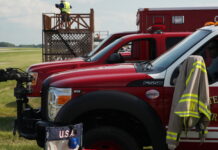Over the years, many air shows have battled weather issues when wind, lightning, rain, heat and other concerns have resulted in last minute changes to performances, crowd placement, site adjustments, general safety needs or even “go-no-go” decisions. However, what happens when an evening storm whips through and renders parts of the site questionable, even though the next show day’s skies are clear and ready for a full day?
Numerous factors can turn site changes into a “go/no-go” decision, and they’re not easy to make. For example, a lighter cold wind and rain can make spectators uncomfortable, but most performers can still carry on. As producers, we know a lot of the fans would stick around and wait out a rain delay, just as they do at baseball games and auto races; however, rather than subject our patrons to an indefinite wait and gamble with hidden safety issues, as well as ask our performers to re-strategize and re-focus on their performance, are we really doing what’s best for our customers safety? Are we making all our decisions for the right reasons?
In the outdoor event business, spectator safety is unfortunately not always the first reason for making such a tough call. When a headliner concert band refuses to go on stage because of the threat of lightning, wet equipment or electrical concerns, a promoter or producer has little choice but to postpone or cancel the show, and most performers will agree to a delay as long as they’re comfortable that personal safety is addressed, but patron safety is rarely the deciding factor.
In the air show business, all the planning in the world may not be worth a plugged nickel when a major storm hits and subjects a show site to a variety of possible concerns. Yes, the sky might be clear and all the performers are able to fly, but are you certain … “absolutely certain” that the grounds will not pose any safety concerns for the patrons? Is there anything under those water puddles that could seriously injure an adventurous youngster who thinks wading through the water is more fun than watching the wing-walker? Might there be any power cables or generators in an area that was even temporarily under mud or water and is there any chance at all for electrical malfunctions, potential sparks, flash fires, or the electrocution of workers, volunteers or patrons? Are all the tent pegs or materials within these areas as secure as they were yesterday, so if a strong gust of wind pops up, are you certain nothing can come loose because of weakened, wet ground areas? What about the kids rides, concessions areas and other displays that you, as the person ultimately responsible for on-site spectator safety, did not personally inspect or direct a crew to set-up or double-check? Are you prepared to take someone else’s word that their designated site amenity, display or area of responsibility is 100 percent safe?
If a plane goes down inside or even slightly outside the show box, are the water-soaked routes and wet ground areas capable of supporting emergency vehicle traffic, so they can reach a downed aircraft and pilot in a timely manner? Did you ask anyone to actually drive out there to verify general accessibility before making a decision? Did you take the time to investigate alternate routes, knowing that water retention could be an unknown factor in performer safety? Or will you simply roll the dice?
Performers should, but patrons may not always understand the reason tough decisions have to be made, even when their own safety is at heart. “But the sky is clear” is not always the only deciding factor.








